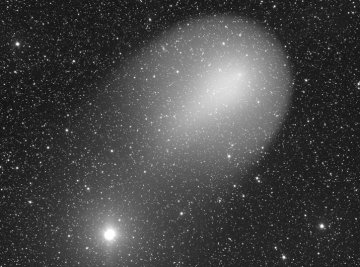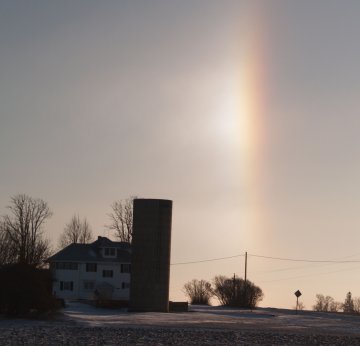 Where's Saturn? Is that a UFO--or the ISS? What's the name of that star? Get the answers from mySKY--a fun new astronomy helper from Meade. Where's Saturn? Is that a UFO--or the ISS? What's the name of that star? Get the answers from mySKY--a fun new astronomy helper from Meade. AURORA WATCH: Sky watchers in Russia, Scandinavia, Canadas and Alaska should be alert for auroras tonight. A fast solar wind stream is blowing against Earth and causing high-latitude geomagnetic storms: gallery. HOLMES AND ALGOL: Comet 17P/Holmes is bearing down on the bright and famous variable star Algol. Jose Francisco Hdez. took this picture of the two converging on Jan. 13th in the skies above Tenerife, Spain: 
Closest approach, star vs. comet, occurs on Jan. 21st and 22nd with only a few tenths of a degree separating Algol from the comet's heart. Algol will shine right through Holmes' inner atmosphere, making it appear that the comet has swallowed the star--a great photo-op for amateur astronomers. Almost three months after it exploded, Comet Holmes can still be seen with the unaided eye from rural areas. It's a fuzzy patch of 4th magnitude in the constellation Perseus: sky map. City lights make the finding more difficult, but for the next two weeks even urban sky watchers can do it. Simply look straight up after sunset and locate Algol; Comet Holmes is right beside it. A 60-second exposure with an off-the-shelf digital camera reveals the star-comet combo--no telescope required. Comet 17P/Holmes Photo Gallery
[World Map of Comet Sightings]
[sky map] [ephemeris] [3D orbit] [comment] TOWERING SUNDOG: Yvonne Bennett was driving through rural Iowa yesterday, but had to pull off the highway for a quick picture when she saw a sun dog towering beside this farm house: 
"They were beautiful," she says. "I had only read about sun dogs before, but this morning I was treated to a sun dog show for nearly an hour. The one beside the farm was the left dog; here is the right dog photographed moments later." Sun dogs are caused by flat, plate-shaped ice-crystals fluttering like leaves down from high, cold clouds. When these crystals catch the rays of the rising or setting sun, they create rainbow colored "dogs," sometimes blindingly bright. This is a good time of year to see them flanking the sun especially at dusk or dawn. more images: from Mark Williams of Sommand, France; from Laurent Laveder of Quimper, Bretagne, France; from Richard Brady of Waterbury, CT; from Dennis Fournier of Framingham, Massachusetts; | 
